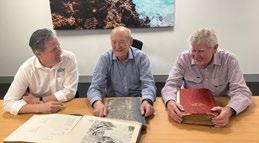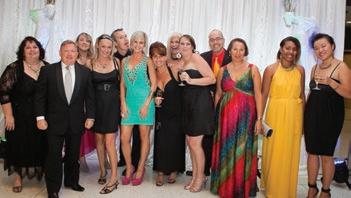







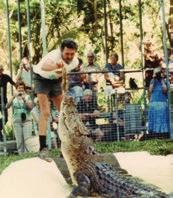










John O’Sullivan
Appointed Director – Chair

Tourism Tropical North Queensland (TTNQ) stands alone in Australia as one of the few industry-born Regional Tourism Organisations, created by tourism pioneers for tourism excellence. As marketing custodian of Australia’s magnificent Great Barrier Reef, TTNQ represents a trailblazing local industry sector built with personal investment and innovation by legends stretching back to the Hayles family in 1924, and Vince Vlassoff and Lloyd Grigg who developed Green Island’s famous Underwater Observatory.
Over the past five decades there have been many visionaries whose legacy continues, like founding Chairman George Chapman whose family is continuing to invest in tourism infrastructure 30 years after Skyrail Rainforest Cableway became the region’s first ecotourism experience. Tropical North Queensland’s tourism industry was developed by family businesses whose owners were proud to live and work in this destination. They understood that marketing the destination together was the way forward and this mantra of hunting as a pack set them apart from their competitors.
This resilient industry has weathered pandemics, pilot strikes, and natural disasters, proving the strength of a community fundamentally built on tourism’s transformative power and enduring spirit. In our 50th year TTNQ remains proud to continue to represent this wonderful region on the world’s stage and to promote its stories, it’s attractions and people. We remain committed to working for you as an industry and look forward to the next 50 years. Happy 50th birthday TTNQ.
Mark Olsen Chief Executive Officer

History is an invaluable teacher and so we pause in the 50th year of TTNQ to look back at five decades of passion, innovation and resilience that have transformed Tropical North Queensland into the $4.5 billion powerhouse of today.
We are fortunate to have our original Chairman George Chapman and General Manager Bill Cummings share their memories of the work to register the Far North Queensland Development Bureau Limited on 12 September 1975 and how they capitalised on a sunrise industry for the region. Reflection shows that the narrative hasn’t changed over time. Our brand has always been about the emotional connection our visitors make to the environment. Our business approach has been to innovate, to treat challenges as opportunities, and to seek partners to amplify our efforts.
Being a successful tourism organisation is all about organising – know what you are talking about, know where you are going, know where you can make a difference and do it together. You must pull the industry in together to make it work and we have been fortunate that our tourism community has been led by businesspeople who understood that – sell the destination first and your business will reap the rewards.
The very first promotional missions in the 1970s created a broader team of enthusiastic industry people who put the destination first. This philosophy has never wavered, continuing to set our destination ahead of others. The Tropical North Queensland tourism industry is ingrained in our community, our friendships, and our way of life. Happy 50th TTNQ.
GM s
1975-1981 Bill Cummings
1982-1984 Alec Martin
1985-1988 Larry Monk
1989-1994 Geoff Donaghy
1994-1998 Steve Noakes
1998-2002 Ian Kean
2002-2005 Bill Calderwood
2005-2013 Rob Giason
2014-2017 Alex de Waal
2017-2019 Pip Close
2019- Mark Olsen
1975-1981 George Chapman
1982-1983 Chris Johnson
1984-1985 Ron Berry
1986-1991 Don Lister
1991-1992 John Vickary
1993-1995 Mike Burgess
1996-1997 Bob Manning
1997-1999 John Ingram
1999-2001 Peter Goulding
2001-2005 Cam Charlton
2005-2009 Stephen Olle
2009-2011 Bill Calderwood
2011-2015 Stephen Gregg
2015-2017 Max Shepherd
2017-2020 Wendy Morris
2020-2023 Ken Chapman
2023- John O’Sullivan






In the early 70s Queensland roads were improving bringing Australians further north and aircraft travel was increasing with international stars like Lee Marvin arriving in Cairns in search of the legendary black marlin. The Kuranda train had been winding its way through the spectacular Barron Gorge since 1891, and in 1924 a commercial tourism operation was established with Hayles boats taking day trippers to Green Island and its underwater observatory. Industry leaders such as Ben Hayles had emerged in the 60s with the reef operator becoming president of the Cairns and District Travel League, one of the first tourism organisations created in the region.
However, most of the region’s business entrepreneurs were from other industries and were associated with the Cairns Chamber of Commerce, including surveyor George Chapman who was among the founding members of the Cairns Regional Development Bureau, established to attract investment in the region. Its first meeting, held on 5 April 1967 and chaired by Alderman Vince Donnelly, drew 27 keen observers. A Tourism Committee was set up that year chaired by J. Golightly.
In 1970 the organisation was renamed the Far North Queensland Development Bureau, with a new constitution to appoint directors representing the geographical,




economic and communal aspects of the region. Not long after, the potential of tourism was outlined in the Great Barrier Reef Visitor Plan, a report delivered by American consultants in April 1971, which came up with the concept of the Great Boomerang for international tourism growth. It recommended Sydney, the Red Centre and the Great Barrier Reef be marketed to Americans, who were driving the growth of international visitation to Australia.
While this debate was unfolding, the Australian National Travel Association (ANTA) released the North Queensland Tourism Study in April 1971, after sending a

team the previous year to assess the tourism potential of the area from Bowen to Cairns. The study recommended establishing the North Queensland Travel Council with development bureaus in Townsville, Ingham and Cairns. In August 1971, the Bureau elected to become a member of ANTA.

In October 1971 the Development Bureau resolved to establish a sub-board for tourism and travel after the Cairns and District Travel League received unanimous approval at a public meeting for a unified tourism body. This resolution led to the launch of Operation Investment, a major fundraising drive by professional fundraisers Compton Associates, which sought pledges from businesses and local government across the region to establish a five-year tourism promotion program.
The inaugural meeting of the Far North Queensland Board for Tourism and Travel was held shortly after, on 23 November
1971. Economist Bill Cummings credited much of the Board’s formation to Johnstone Shire Chairman Roy Dickson who was President and Chairman of the Development Bureau at the time.
The fledgling tourism sub-board was chaired by Cairns Mayor David Thomas de Jarlais with Mr T. Walker, Chairman of the Cairns/ Mulgrave Advisory Committee appointed as Vice-Chairman. Other members included councillors from the Shires of Mareeba, Eacham, Atherton, Herberton, Johnstone, Mulgrave and Douglas.
Operation Investment was officially underway in 1972 and was overseen by a committee of community business leaders




chaired by Carlton United Brewery Manager Peter Forness. The target to raise $200,000 over five years –the equivalent of $2.8 million today –was successful.
Also in 1972, the North Queensland Travel Council was created with Cummings, who was managing the Ingham Research and Promotion Bureau, serving as secretary, and Bush Pilots Chairman Sir Sydney Williams, the Chairman. While planning the first consumer travel promotion in 1972, Cummings approached local printer Bob Bolton, whose colour photography had been widely used in tourism

brochures. Bolton’s photos were incorporated into a cutting edge visual and audio presentation, which was later adapted for trade audiences. The Travel Council gradually faded when Cummings was appointed Manager of the Development Bureau in 1973. It was eventually abandoned in 1975.


The FNQ Board for Tourism and Travel gained momentum following the appointment of Irishman Sean O’Hagen as Tourist Promotion Officer in May 1972. Having previously promoted tourism in New Zealand, O’Hagen brought valuable experience to the role. Under his tenure, information centres were established in Cairns and later in Mourilyan, and development began on the Australian Sugar Industry Museum.
A regional Tropic Wonderland film was produced in association with TAA, supported by promotional brochures describing the region as “warm, green and friendly”, and annual visitor guides were published. Relationships were developed with the Australian Tourism Commission (ATC) and the Queensland Government Tourism Bureau to host visiting agents and journalists on familiarisations (famils). The region also moved quickly to organise promotion teams for regular industry travel shows like ANTA, Talkabout and Destination Australia.
The Gold Coast had long dominated destination marketing in Queensland, but the Far North was beginning to make its presence felt with strong industry support. “We were the new kid on the block,” said Cummings. “Our first promotions in 1973 were supported by the airlines who flew our
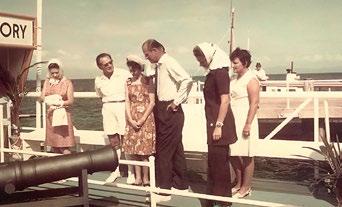


industry team south to promote the destination. We wore white safari suits as a uniform. To create a broader team, Sean and I were joined by industry including Ben Hayles, Bush Pilots senior air hostess Pam Wattling, and Percy Trezise who was promoting the Quinkan rock art galleries.”
Trezise had recently uncovered the extent of the now-famous galleries near Laura and was actively advocating for their protection. He also helped establish the Indigenous Laura Rangers. Cummings hoped Trezise’s unique story and cultural advocacy would help attract media interest.

The Board’s quest for media attention was achieved the following year when Gary Zillfleisch (pictured) from Hartley’s Creek Zoo took a 1.5m crocodile to shopping centre promotions in Canberra, Melbourne and Sydney. Cummings said his carefully prepared projector visuals were immediately upstaged as soon as the croc appeared. “I can remember being in a hire car with Gary and the croc was lying across the back seat behind me. We took it into a newspaper office in Melbourne and the staff insisted on putting it in the editor’s office facing the door with journos bowling into the room and being confronted by a croc.”
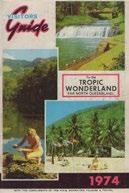







12 September 1975
Far North Queensland Development Bureau Limited registered
July 1978
Last meeting of the Far North Queensland Board for Tourism and Travel (sub-board of the FNQ Development Bureau)
August 1978
Bureau name change to Far North Queensland Promotion Bureau Limited

1998
Tourism Tropical North
Queensland business name change
11 January 2023
Tourism Tropical North
Queensland Limited company name change registered
A fully fledged tourism promotion bureau emerged in the mid-70s after a series of changes to the organisation and its name. Modern day records show the Far North Queensland Promotion Bureau Limited was registered under the Corporations Act on 12 September 1975 as a non-profit company limited by guarantee, but this name did not come into use until 1978, as reflected in the FNQ Development Bureau minutes from 1975 to 1978.
The subscribers to the Memorandum of Association were George Chapman, civil engineer Alan McPherson, former Mayor David de Jarlais, Peter’s Ice Cream manager Keith Geary, surveyor Donald Michael, mechanical engineer Don Fry and pharmacist Peter Cominos. This change is celebrated as the birth of the first professional destination promotion organisation for the Far North. It is arguably the first Regional Tourism Organisation in Australia and preceded the State Tourism Organisation by four years.
At this time, the Board for Tourism and Travel was still operating with its Chairman Tony Mijo, who also served as the Douglas Shire Council Chairman. He was later succeeded by Gordon McKauge, a local businessman who had established a new coral jewellery manufacturing enterprise. Around the same time, Kim McDowell, who had been working for the Federal Tourism Minister, became the Tourism Promotion Officer.
In May 1978 the Board agreed the two separate names of the Board and sub-board be discontinued, and the name Far North Queensland Promotion Bureau Ltd be adopted.
The last meeting of the Far North Queensland Development Bureau Limited Board was 26 July 1978 with the name changed for the next meeting in August.
The Bureau Board was expanded to include additional members from the tourism industry.

Charlie Woodward, who had opened Mountain Groves in Kuranda and founded Tropic Wings in 1976 with his wife Pip, chaired the Visitor Information Committee overseeing the development of a new visitor information centre in Cairns at the former Fire Brigade building in Lake St.
The FNQ Ambassador Club was formed on 27 June 1978 with Helen Hogan as Chairman to bring together the Bureau’s subscribers in a social atmosphere with the first event at Hides Hotel.
Domestic air passenger numbers had risen almost four-fold over the 10 years to 1979, surpassing those through Townsville. By then, Cairns had also become the international gateway for services to Papua New Guinea and Irian Jaya. However, when the Parliamentary Select Committee report was released in late 1979, it made the surprising recommendation that Townville, not Cairns, be upgraded as the main international gateway in the NorthEast. In response, the Bureau dedicated much of the next two years to working with community organisations to advocate for an upgrade of Cairns Airport to accommodate wide-bodied aircraft for long distance international flights.
Although the Commonwealth Government indicated Cairns ranked low in funding priority, it did highlight a scheme to transfer ownership of regional airports to local communities. A public meeting was convened, where Chapman, Mayor Ron Davis, Cairns Harbour Board Chairman



Mick Borzi and four others formed the Cairns Airport Development Committee.Their first meeting was held on 20 February 1979 to investigate feasibility of local ownership.
Cairns’ case was strengthened when the city hosted the first Japanese tour groups. Air Niugini, which had developed services to Kagoshima and then Fukuoka in Japan, asked the Bureau if they would host a series of Japanese tour groups each week. The Bureau organised itineraries to the Atherton Tablelands and the Great Barrer Reef with Saturday

evening dinners hosted by Bureau members. Each visitor was also presented with a Certificate of Honorary Citizenship.
Chapman and his wife Margo hosted the first dinner on 8 December 1979. Despite the language barrier, the Japanese guests thoroughly enjoyed themselves. Chapman said around 800 Japanese did the tours while they lasted. “They loved Cairns, and this convinced us that if we could get direct flights from Cairns there would be a significant tourist market for us.”














The push for an international airport had hit full throttle, but debate raged in the community over the local ownership proposal with The Cairns Post Editor Alan Hudson writing “this has split the town as we have never seen it split before”.
Cairns’ case for an airport upgrade was further strengthened after a discussion between Chapman and a US airline executive, who recommended commissioning a report on the region’s potential for international tourism from the
San Francisco-based Pacific Asia Travel Association (PATA). Acting on this advice, Cummings flew to Papua New Guinea, where PATA representatives were conducting a study, and asked for their assistance. Soon after, PATA tourism experts from the United States, Japan and New Zealand, along with an Australian contingent comprising representatives from Ansett, TAA, ATC, Queensland Tourist and Travel Corporation (QTTC) and National Parks visited the region and reported favourably in early 1981.
At the time, a major concern for the Cairns community was the proposal for Council to lead the airport ownership. The debate was quelled when it was announced the Cairns Harbour Board would take over negotiations from Council. The Cairns Airport Bill was passed in State Parliament and on 14 December 1981 the Board, which had by then become the Cairns Port Authority, officially assumed control.
Chapman later wrote that the airport upgrade was as critical
to the community’s future, as the original development of the railways in the late 1800s.
“I’m convinced that this is the single most important project in Cairns in the second half of the 20th century, and I don’t say that lightly,” he said. “The success or failure of this airport will decide whether Cairns is a satellite city in the Townsville region or whether Cairns continues to grow and prosper as a vibrant economic centre of a region on its own.”
Among the staff to work at the Bureau in its early years was Jill Hynes, who initially stepped in to assist in 1979 while Cumming’s administration officer was on leave. Hynes and her husband Ted had purchased The Reef House in 1975 from Brigadier David Thomson who had gone on to become the Member for Leichhardt. Hyne’s tourism expertise quickly proved invaluable, and she remained with the Bureau as Tourism Industry Liaison Officer, representing the organisation at trade shows including Talkabout and the Australian Tourism Exchange. When the couple sold The Reef House in 1981, they went on to establish the first inbound tour operator north of Brisbane, Inbound North Australia. Hynes also started the local branch of PATA becoming the North Queensland representative.







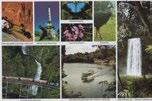
Around the same time, the Bureau was forced to relocate its offices and information centre from the old Fire Brigade building to temporary premises in Abbott Street to make way for a Council parking station. Both Chapman and Cummings departed in September 1981. Journalist Alec Martin was appointed General Manager (serving until 1984), and Carlton & United Breweries Manager Chris Johnson became Chairman in 1982 and 1983 before leaving Cairns and handing over the reins to his deputy, Ron Berry, then Douglas Shire Deputy Chairman.

The $35 million redevelopment of Cairns Airport was scheduled to open on 31 March 1984 with the week of 17 March to 3 April 1984 dedicated to a series of celebrations including three free concerts featuring Dame Edna Everage, Red Gum and Rose Tattoo. The timing could not be better as Tourism Australia’s Shrimp on the Barbie advertisement with Paul Hogan had resonated with American audiences the year before. Qantas announced discounted airfares between North America and Cairns, while local
tour operators offered 30-50% discounts on accommodation, reef trips and bus tours.
General Manager Larry Monk arrived in 1985 after a career that included tourism and economic development with local government on the Central Coast and a role as a NSW tourism commissioner. What he didn’t realise when applying for the job was that the organisation was in substantial debt due to huge cost blow outs with the Cairns International Airport opening promotions.



“During my interview they asked me to leave the room after I asked about the budget. I was told what the budget was – just not that it was in the colour red. A friend working at ATC asked why I accepted the job, saying ‘don’t you realise they are broke’. I rang Ron Berry, the Chairman at the time, to ask what was going on and he sent clips of The Cairns Post in the mail – it was the first I heard of their financial difficulties,” Monk said.
Far North Queensland Electricity Board General Manager Don Lister became Chairman in 1986 and provided a stabilising influence on the Board. He supported Monk’s efforts to restructure
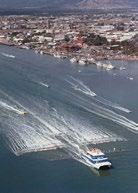

the organisation and return it to financial health. The first step was expanding the membership base using a proposal developed after conversations with Quicksilver’s Jim Wallace and Max Shepherd, Charlie Woodward, John Morris and Monk, to include all businesses that directly or indirectly benefitted from tourism.
“The Bureau wanted to increase the annual income of $250,000 by $500,000 through new membership levels including special recognition, gold, silver and bronze to include everyone in the industry. Previously members paid whatever they wanted to give and there was a lot of contra but no
cash. Unfortunately, contra doesn’t the pay bills,” Monk said.
As industry optimism surged, so did membership. “It seemed like a new hotel opened every six weeks. They were very exciting times with fantastic job growth,” Monk reflected. At the time, six major tourism projects worth a combined $325 million were under construction including Trinity Wharf, Hilton, Sheraton Port Douglas, Park Royal, The Pier and Port Douglas Marina. The hotels would add another 1050 rooms to the destination bringing the total room stock to 3699.
Showcasing the growing destination was critical to the success of these investments.
The Bureau’s small team of five included two staff dedicated fulltime to hosting famils for visiting trade and media, and often on a shoestring. “The industry came to the party, and nobody refused us a bed or a tour to host famils. Charlie Woodward used to say ‘FOC means friends of Charlie’s,” Monk laughed.
Monk credited a core group of committed industry figures with helping to market the destination, including Charlie Woodward, Jim and Jo Wallace (Quicksilver), Moss Hunt (Silky Oaks), Peter Miller (Tuna Towers), and Rob Prettejohn (Kewarra Beach Resort). Others
included Denis Ferguson from Bush Pilots, who co-founded Destination Management Company with Denis Donaghy in 1986; Graham Gordon, former sales manager for Hayles and later Great Adventures; Jill and Ted Hynes (Inbound North Australia); and Ray Rogers from the former Holiday Inn on Sheridan Street. Many of them travelled together on trade missions.
“They worked together and socialised together and didn’t try to outsmart each other. They were more interested in growing the region and saw a great opportunity to do that. In my position I was very lucky to have them. The Gold Coast was very competitive with each other, which made us stand out.”
Having local airline managers also proved invaluable. “We formed an alliance with Ansett which was very helpful as they provided office space, flights for us to do presentations to domestic agents in all capital cities, and they did all the work to get the agents to the sessions,” Monk explained. “Noel Davidson was a very pro-active Cairns manager of Ansett at the time. Qantas Cairns Manager Max Plummer was also supportive and provided heavily discounted or FOC flights. I think we were the only region to get that support from the airlines, particularly in the domestic market.”

In 1988, talks were scheduled between Australia and the US to negotiate the next round of aviation rights. The Queensland Tourist and Travel Corporation (QTTC) was advocating for flights into Cairns and Continental Airlines had expressed an interest in operating services from Hawaii to both Brisbane and Cairns. QTTC Chairman Sir Frank Moore, working with the Australian head of Continental, orchestrated a bold and unexpected intervention. According to former QTTC Deputy CEO Ian Kean, they borrowed Christopher Skase’s private jet to fly the entire US negotiating team from Canberra to Cairns for the weekend. Kean flew in separately to meet them. They stayed at the new Sheraton Mirage at Port Douglas,
snorkelled on the Reef with Quicksilver, took a helicopter to Cape Tribulation and played golf before returning to Brisbane to see Expo 88 and then Canberra. QTTC’s goal was to show the US team, most of whom had never visited North Queensland, exactly what their fellow citizens could enjoy if flights into Cairns were approved. “During the weekend the senior US government official called his boss in the States saying he had better come over as they needed to get the rights into Cairns. He arrived to join the talks and Continental started services into Cairns and Brisbane soon after. Airlines from other countries followed demonstrating the need for direct services into Cairns,” Kean said.
Monk left to become North Queensland Director of Marketing for Daikyo whose developments included the Cairns International, Matson Plaza, Paradise Palms Golf Course, Forest Gardens, the Village Arcade and Yamagen restaurant. In 1991 Daikyo purchased Green Island Resort and Great Adventures from Dreamworld Corporation and announced plans to rebuild the resort, which had been closed since 1989.
Sales and Marketing director of the Ramada Resort at Palm Cove Geoff Donaghy became FNQPB General Manager in January 1989 when the tourism industry was booming. Eager to accelerate international marketing, Donaghy’s plans were disrupted when pilots walked off the job following a busy winter season. The dispute dragged on through summer into 1990, effectively cutting off the flow of visitors to Cairns.
Tourism was worth $400 million to the region and suddenly there were no customers. Donaghy met Prime Minister Bob Hawke in his suite at the Pacific International Hotel alongside Federal Member for Leichhardt John Gayler to discuss how reliant Cairns was
on tourism and how its economic benefits filtered down throughout the entire community. “We moved into survival mode for a while, watching businesses go broke and friends lose their jobs. It was a very sad time. But from chaos comes opportunity,” he said.
The first opportunity was to demonstrate just how dependent the region was on tourism as an economic driver and on aviation to deliver visitors. The Bureau developed case studies to demonstrate how pharmacies, dry cleaners and even day care centres benefitted from tourism and how those dollars dried up when jobs disappeared. Donaghy, a former school teacher, even did school visits to increase awareness. “On the Tablelands, I took out a dollar and said the tourist brings this into town. They use it to stay at a hotel and buy dinner made with food grown on the Tablelands, which goes to your parents and ends up as your pocket money.”
Cairns Rent a Car owner John Vickary, whose business was decimated by the Pilot’s Dispute, was elected Chairman in 19911992. With the Board’s support, Donaghy began leading dedicated







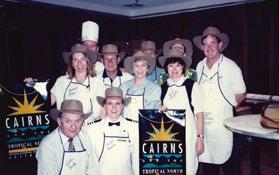
Clockwise from top left: Geoff Donaghy and the FNQPB team 1992; Roadshow early 90s; Pilot’s Dispute; trade show mid-90s; Europe 1991 Paula Quirk, Ros Harries and Larry Monk; MICE conerence 1992 Kerrie Richmond (FNQPB), Judith North (Quicksilver), Louise Pronk (Matson Hotels & Resorts) and Therese Fordham (Cairns Colonial Club Resort); FNQPB c1995; Ian Kennedy, 4WD operators representative John Hardaker and Savannah Guides ounder John Courtenay at PATA 1990 launch oa study into Cape York Peninsula.
Bureau trade missions, moving beyond simply participating in QTTC promotions. It was the second opportunity.
“It worked because Cairns was made up almost exclusively of owner operators,” Donaghy said. “They enjoyed working together and there was a lot of passing of leads to each other at trade shows. The region’s operators became well known and other destinations used to say, ‘you guys hunt as a pack’ and it stuck. We started doing missions in our own right in Japan and copped criticism from the Federal Tourism Minister, but the operators wanted to grab their destiny in their own hands.”
In his 1991 annual report, Donaghy wrote that the Bureau’s strategy was to participate in the greatest possible number of promotional activities in Australia and overseas that resources permitted to recover from the downturn brought on by the Pilots’ Dispute. “The Bureau is now acknowledged as one of the most active, aggressive and effective tourism promotional bodies in the country and with the advent of domestic airline deregulation price initiatives and the continuing growth of our international markets, the region is now experiencing the strongest growth and recovery of any destination in Australia.”
It was also time to act on another opportunity Donaghy had identified before the dispute, attracting conventions to help build a visitor industry, as other successful cities had done. “A visitor industry is much broader than a tourism industry and a purpose-built convention centre is an integral part of that.” With the five-year exclusion period for a casino to be built in the north ending, the Bureau lobbied Member for Cairns and Treasurer Keith De Lacy for the winning casino tender bid to include funding to develop a convention centre.
Donaghy left in 1994 to head up the Cairns Convention Centre while it was under construction and Steve Noakes, who had served on the FNQPB Board, was appointed General Manager from 1994 to 1998 with Quicksilver’s Mike Burgess the Chairman from 1993 to 1995. With the support of Cairns Mayor Kevin Byrne and Port Authority CEO Bob Manning, Burgess led a major change to the Board’s structure, removing the requirement for geographical representation. This allowed more tourism representatives, rather than local government directors, to take leadership. Within a year, TTNQ had the largest membership of any tourism organisation in Australia.

By the mid 1990s, Noakes and the Board decided it was time to rebrand the destination to better reflect its identity and potential. Manning, who was elected Chairman in 1996, strongly supported the move, concerned that wholesalers and airlines were shaping a version of Far North Queensland that suited their sales strategies, not the region’s unique offering. There was no existing blueprint for a regional destination to reposition itself, but with a $50,000 grant, the Bureau partnered with Tourism Queensland (TQ) and the Australian Tourist Commission (ATC) on what became the Brand FNQ Report. It was the first time three levels of Australia’s tourism organisations collaborated on a joint marketing initiative.
Many, including Noakes, were keen for the Great Barrier Reef to be part of the core destination name. “ATC CEO John Hutchinson, who I knew through our involvement with PATA, had steered the new Australian brand approach promoting big nature experiences as a competitive advantage,” Noakes said.
“Cairns delivered on this promise with the Reef and the outback, but we had to go through a strategic process to fully understand the market performance to date, the current situation and where we wanted to go in the future. With the support of ATC Chairman Don Morris and John Morris of Port Douglas, we were able to harness the necessary skills, networks and resources to undertake the ground-breaking destination research.










With the Cairns Convention Centre opening on 26 June 1996, Liz Bindon-Bonnie was appointed the first dedicated convention specialist for the organisation bringing experience from Perth and a new skillset to attract conventions to the city. “The organisation and the destination had such a good reputation that we were able to attract good people to TTNQ,” Noakes said. It also brought new opportunities to develop businesses to support the fledgling business events industry with Donna and Peter Anderson founding NQ Exhibitions.
“The Great Barrier Reef was a key experience and my thinking at a national level was how Cairns could take ownership of Great Barrier Reef experiences to become Australia’s dominant gateway to the Reef. The research showed the Great Barrier Reef branding was very strong for Cairns. We had good support from ATC, but not from TQ who said they could not support one coastal Queensland destination taking ownership of the Reef. It shows how politics plays a role in destination marketing when you need the marketing funding of the State Government’s tourism authority.”
Tourism in the region was evolving and diversifying, with Australia’s first bungy jump, the growth of white water rafting, and new owners at Paronella Park, and was set for an upward trajectory with the opening of The Reef Hotel Casino on 31 January 1996. Monk had joined their marketing team to create the city’s most extravagant opening event. Abbott St was closed for one week to erect a marquis for 500 tourism identities including wholesalers and ITOs to be treated to a spectacular evening of dining and entertainment by Dame Edna Everage and jazz musician James Morrison.




Clockwise from above: Chris Cowans (Quicksilver), Tracey Vince (Cairns Colonial Club Resort), Michael Sweeney (Tropic Wings), Vivian Reid (Wild Track Safaris) and Jane Thornhill (RnR); 1991 Europe Colin Smith, Jane Thornhill and Mike Burgess; Geoff and Denise Olholm 1994 Tourism Awards; Kerrie Richmond; Stephen Gregg and Geoff Donaghy; Pre-Skyrail Save the Rainforest party.









Steve Noakes and Bob Manning both announced their departure at the 1997 AGM, with Cairns Hilton GM John Ingram elected before being transferred in 1999. Limousine operator Peter Goulding, who had worked with ATC, served from 1999 to 2001, bringing international experience to the Board for the first time.
TTNQ Director Cam Charlton, who headed up the finance committee and served as Chair from 2001
to 2005, said the organisation went through a significant cultural change. “We are a membership organisation, but our role is not to service members, it is to grow the destination for the benefit of all members. We decided to double the salary and move from a general manager to a chief executive officer role to attract a different skillset and make a quantum leap forward with the results we were trying to achieve.”





Ian Kean had returned to Brisbane after five years as CEO of the New Zealand Tourism Board when TQ CEO Stephen Gregg, who later chaired TTNQ, reached out. TTNQ’s general manager had just left, and the organisation was in trouble. Gregg asked Kean to travel to Cairns to meet with the Board.
Reluctant at first, Kean finally accepted the challenge. “I like fixing things that are broken or starting something new,” he said.
“TTNQ needed rebuilding, so I brought in new managers and
staff including Leigh Sorensen as Marketing Manager. BindonBonney was already in situ as the Convention Manager with good experience to grow this business,” Kean explained. “TTNQ formed a new operation, the Cairns and Region Convention Bureau with her in charge and actively sought national and international conventions and incentive group business, working with the team from the Convention Centre, and becoming a full member of the Australian Association of Convention Bureaux.”





TTNQ was based in the Port Authority building, but they were asked to vacate the space. Kean contacted Cairns Mayor Tom Pyne who was very supportive and suggested the recently vacated Mulgrave Shire building as its new home. With backing from Cairns Regional Council, TTNQ moved into the facility, furnished with spare desks and chairs free of charge, and made minor alterations to allow the Visitor Information Centre to operate from the front section of the building.
Tropical North Queensland’s strong international visitation was unusual for an Australian tourism region, with Cairns attracting more international holidaymakers than any state or territory, apart from Queensland and New South Wales. Kean bought this to the attention of the ATC to argue for TTNQ’s inclusion as a seller at ATE, after regional tourism organisations had initially been excluded from participating.
However, his key challenge was the declining Japanese market dominated by wholesalers selling four-day itineraries including two or more destinations with domestic flights. Visitors were worn out by Japanese companies ferrying them around on tours from dawn to

dark and TTNQ thought they would prefer four days or more in one place for a holiday break.
Well connected with senior figures in Japan’s travel industry, Kean understood meaningful negotiations needed to happen between decision-makers. He travelled to Japan to meet with the presidents and vice-presidents of major wholesalers, pitching the idea of Cairns mono destination holidays. These were four to fivenight packages where travellers would fly into Cairns, unpack, have a holiday and then fly home. The strategy worked with one major wholesaler, HIS, selling more than half their total Australian business as Cairns mono holidays.

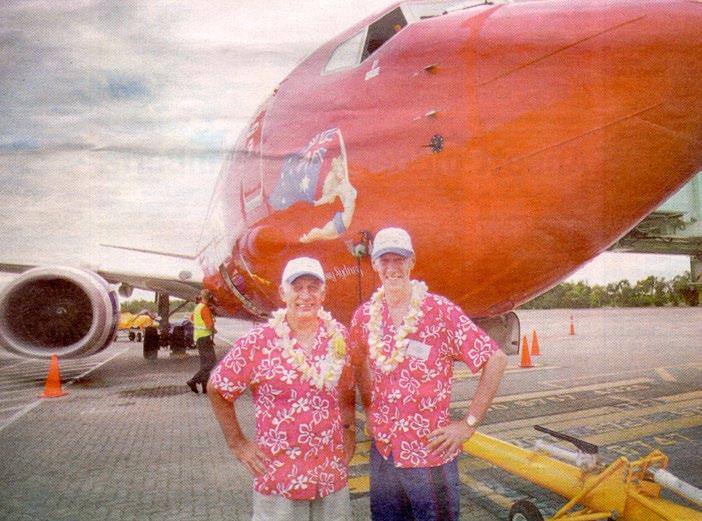
In 2001, Qantas announced a new low-cost subsidiary airline to service Asian destinations. Kean immediately contacted TQ and the Cairns Port Authority to develop a strategy for Cairns to be the base for this new airline, with existing Qantas services being able to feed into Cairns from all over Australia. They were successful with operations starting in 2002 thanks to a generous incentive from the Port Authority with CEO Bob
Manning discussing the landing fee reductions that Australian Airlines was seeking with his chief financial officer Neil Quinn. “Neil suggested we give them a bargain price to get an airline hub for Cairns. This resulted in six or seven 767s operating in and out of Cairns twice a day to five airports in Japan. The State Government was not happy that we got it in Cairns,” Manning recalled.


After four years Kean felt he had turned the organisation around and helped to recruit former ATC Deputy Managing Director Bill Calderwood to take on the role in 2002 and maintain the destination’s momentum. “If you want to run a regional tourism body then TTNQ is the one because it’s bigger than some States and very challenging. At the time it was the second largest international destination behind Sydney,” Calderwood said.
The industry’s success lay in it being well informed and excelling in engaging with the industry overseas. “We ran annual tourism industry forums with experts to talk to industry about issues and trends. As an organisation we were
very keen to pick the brains of the tourism bodies so we could be one step ahead in terms of knowledge and get funds in terms of leverage.”
Partnerships also played a vital role. Calderwood joined the marketing committee of Australian Airlines, giving TTNQ a seat at the table in shaping how its $18 million three-year marketing budget was spent. He maintained a strong working relationship with the Cairns Port Authority, where TTNQ was seen as the airport’s de facto marketing arm, driving inbound traffic to the region. Funding support remained solid, with contributions from TQ, TA, membership fees and occasional grants helping to sustain and grow the organisation’s efforts.
Not long after he started, Calderwood was approached by Tablelands Mayor Jim Chapman and TTNQ’s John McIntyre who had identified funding to develop heritage sites. TTNQ was working out of the old Mulgrave Shire Council Chambers and used the $1.6 million funding to develop the historic building into a modern interactive visitor centre and renovate the upstairs offices into a functional working environment, which Calderwood said was a major boost in the way TTNQ engaged with the public.



Calderwood also formed Tourism Action Group teams made up of strategic thinkers to come together to help future proof the Tropical North Queensland tourism industry. These groups were divided into five key markets: business events, domestic, backpackers, gay and lesbian, western and eastern hemisphere. This was invaluable in getting the industry to work together with people such as Raging Thunder’s Fred Ariel and Queensland Backpacker’s Stephen Welsh bringing their expertise in their special interest area of backpacking.


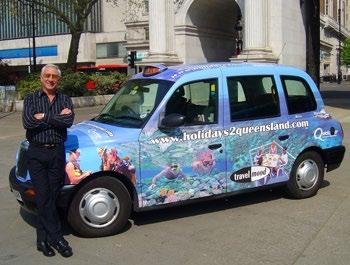





International trade marketing was a critical pillar of success throughout the 90s. During this time, a core group of industry ‘road warriors’ emerged. These included Todd Parker, Robbie Bastion, Michael Healy and James Dixon. They were regularly joined by Andrew Steel, Ron Livingston, Judith North, Chris Cowans, Cheryl Kelly, Ros Harries, Michael Bowmaker, Paul Kamsler jr, Rod Punshon, Angela Freeman, Stephen Olle, Peter Blackburn, Chris McKinley, Phil Hobbs, Lloyd Smith, Marc Ryan, Gary Young, Mark Burns, Patrick Blewitt, Paolo Gambino, Claudia McFadden, Rosie Douglas, Sharyn Brydon, Marc Sleeman, Michael Heaver, Rob Prettejohn, Judy Freeman, Michael Nelson, Barbara Thomson, and Shelagh Murphy. They travelled the world promoting the region alongside TTNQ’s staff Leigh Sorensen, Paul Sumner and Harry Nihori.
Under Calderwood’s leadership, the phrase Cairns & Great Barrier Reef became a central part of the region’s international brand identity, particularly in Asia where it had a stronger resonance. “The Great Barrier Reef is one of the best-known tourism experiences in the world and Cairns is the gateway, so we needed to work to our strength. It would work better to integrate the sub-regions to get more spin off and extend length of stay.”


Tourism Tasmania CEO Rob Giason was tapped on the shoulder by Calderwood to take over as TTNQ CEO in 2005. Excited to join a membership-based organisation with a solid industry reputation and strong international visitation, Giason quickly discovered he was in for a turbulent ride. Just two weeks after arriving in Cairns, Chairman Cam Charlton called with a warning – Daikyo was about to make an announcement, and he believed the company might be pulling out of Cairns. “We quickly entered a period of turmoil. My first official function was the farewell for the Daikyo CEO, a company that had poured billions of investment
dollars into tourism infrastructure in the region,” Giason recalled. Things escalated further in June 2006, when Australian Airlines pulled out of the market. Two years later, Qantas dropped its Narita double dailies, shutting off a major pipeline for the region’s largest inbound market. “Overnight, the tap was turned off for the 240,000 Japanese visitors we were receiving annually. I had history with Jetstar and was able to work with them to get services in, but there was a lot of resistance from industry because there were changes to the airline booking and travel industry business model.
“However, we had to be at the forefront because Japan was so important to us and had dropped to 100,000 visitors overnight.”
Stephen Olle was appointed Chair in 2005 to 2009 and recalled the initial resistance to using lowcost carriers with TTNQ working to understand the supply side of this sector. “The emergence of low-cost carriers was one of three issues during my tenure, including the Global Financial Crisis stifling inbound tourism, and the ongoing growth of Online Travel Agents impacting our traditional distribution model,” Olle said.
Cyclone Larry in March 2006 was the first major weather event to impact the region during Olle’s and Giason’s time. Next was Southeast Queensland’s devastating 2011 floods followed by Cyclone Yasi in 2011 which halted domestic travel. The region’s largest international market was decimated later that year by the Japanese tsunami. “Valuable lessons were learnt during these tough years resulting in TTNQ devising a strategy to future proof the industry that has resulted in our region driving tourism growth in Queensland and Australia,” Giason said.
The new strategy focused on diversifying the current market segments and on attracting sporting and cultural events in the shoulder seasons, which would
bring people into the region who were not constrained by the vagaries of the leisure market. The then Events Queensland CEO John O’Sullivan and Cairns Airport CEO Stephen Gregg were great advocates for the strategy. The formula to diversify worked with the first major event, the Cairns Airport Adventure Festival including Ironman, delivering an $8.8 million boost to the economy in 2012. Giason said it was fantastic to see the community embrace events. The region’s reputation grew with Cairns hosting the Mountain Bike World Cups in 2014 and 2016, and the 2017 UCI Mountain Bike World Championships.

In October 2012 the first direct flight from mainland China arrived in Cairns with the China Eastern service from Shanghai the first step in TTNQ’s goal of 200,000 Chinese visitors by 2015. While there was broad community acceptance of the Japanese market, Rob was concerned the Chinese market was growing a bit faster than could be managed. “It was important for people to be welcoming and so we launched a community engagement campaign to be China ready, working with the media to teach locals how to greet visitors with ‘ni hao’ and understand cultural differences as well as the enormous economic impact this market could have for our community.”


With eight years and three months under his belt, Giason was TTNQ’s longest serving leader, choosing not to leave when the industry fell on hard times as he felt it needed stable leadership. TTNQ pitched to become the first regional destination to host ATE in 2014 and Giason, who stepped down in 2013, was a little sad to attend as a visitor rather than a key player but was proud to see the strong community engagement that he had initiated result in one of the best received ATEs in its history. Giason and his wife Leonie continue to call Cairns home – fully committed to the sales pitch. Bill Calderwood returned to become Chair from 2009 to 2011, after which Stephen Gregg was appointed.

Alex de Waal, who had led TQ’s marketing and Sunlover Holidays, arrived in 2014 to steer TTNQ as it grappled with the positioning of the Tropical North Queensland brand and the need for new hotels after a 20-year hiatus in development. “We needed to reinvigorate the destination and find new ways to drive industry forward with positive media and PR to be regarded by the rest of the world as leading tourism globally. We introduced an innovation conference with a stellar
lineup of speakers to demonstrate that Cairns was an innovation hub and inspire enthusiasm within the community that we had a lot to offer,” de Waal said.
A Destination Positioning Review found the name Tropical North Queensland had the greatest appeal to focus groups as did the tagline ‘Where Rainforest meets the Reef’. With this direction established, de Waal met with TA, Austrade, Cairns Regional Council and the Cairns Chamber of





Commerce to look at product development and infrastructure. TTNQ assessed current accommodation offerings and identified potential for future growth and investment. Armed with a professionally developed prospectus to build investor confidence, the organisation leveraged Austrade networks to bring investors to the region and promote the destination’s longterm potential.
“That process snared Ghassan Aboud, who then built the three Crystalbrook hotels in Cairns, the biggest highlight of my time
at TTNQ,” Alex said. “On the first day he came to Cairns with the Chamber of Commerce, he was so enthusiastic about the destination, and I met with him on a number of occasions.” Aboud’s decision to invest in Cairns and his use of the name Crystalbrook was cemented when John Morris hosted Aboud at his Crystalbrook Station on the Atherton Tablelands. A delighted Aboud caught a 1m long barramundi, declaring that night that the Tropical North was the place to be in his quest to find a destination to build a new hotel brand.


In 2016 and 2017, back-to-back coral bleaching events on the Great Barrier Reef triggered international media coverage suggesting the Reef was dying. Then-CEO Alex de Waal wanted to change this perception. “The image of the destination is very much linked to the Great Barrier Reef, so we needed to balance to the conversation. TTNQ took the
bold move to invest in Citizens of the Great Barrier Reef, a concept I developed to enable people to take ownership of the Reef. When people have a sense of ownership, it engenders support, empathy and commitment resulting in a powerful citizens movement to provide a balance of perspectives in the media,” de Waal said.
Chair Max Shepherd (2015-2017) took over from Gregg and during his tenure, the TTNQ Board made the strategic decision to close the Cairns Visitor Information Centre on the Esplanade in 2018 after considering the organisation’s strategic direction. “We needed to consider whether TTNQ’s role was to bring people into the region or to service them once here,” Shepherd explained. “All hotels plus local travel agents service the market with information and sales, and while the VIC provided a balance of independent advice, it was at a cost to marketing the region.”
Wendy Morris, a marine biologist, businesswoman and daughter of tourism pioneer John Morris, was appointed chair in 2017, right in the height of the negative Reef publicity. “We joined discussions with Tourism and Events Queensland (TEQ) about how to work more closely with the Great Barrier Reef Marine Park Authority and the Australian Institute of Marine Science and came together with much stronger collaboration in 2018-2019 to work through a communications strategy,” Morris said.

“Savannah Guides founder John Courtenay championed the concept that became the Master Reef Guides program, which has been instrumental in delivering accurate, science-based Reef messaging. It also resulted in valuable research exploring how tourism and science aligned post bleaching, giving us a closer communication network for a more resilient industry.”

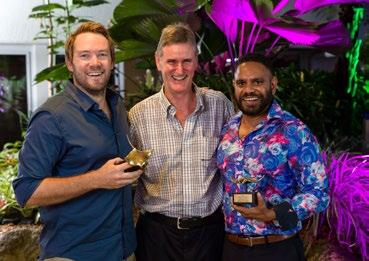




In 2017, Augusta Margaret River Tourism Association CEO Pip Close was appointed CEO of TTNQ.
Listening to industry feedback, she reintroduced the Cairns & Great Barrier Reef branding to support international marketing efforts. “It was a good decision, particularly for the European market when the Reef messaging was challenged and it led to a very big campaign. I secured funding from TEQ and employed GlobalSpot in Germany
who led an industry roadshow with a Master Reef Guide which was a huge success,” she said.
Close championed several Indigenous tourism initiatives, including the creation of a First Nations cluster group and secured funding for Mandingalbay Authentic Indigenous Tours. She also worked with Douglas Shire Council to become Australia’s first destination to achieve Eco-Certification.
Wendy and the Board secured a five-year agreement with Cairns Regional Council for $16 million, finally achieving some security for marketing funding. Close invested in PR, working with TEQ to successfully bid for Cairns to host the Australian Society of Travel Writers Conference in 2019, which resulted in extraordinary domestic PR that paid off when the destination needed it most – the COVID-19 pandemic. TTNQ’s current CEO Mark Olsen, whose varied career included developing more than 100

destination management and ecotourism plans across the globe, arrived in September 2019, in time to host the travel writer’s conference and fine-tuned the Cairns & Great Barrier Reef branding to include the brand promise of ‘See Great Leaver Greater’ with the launch on 11 March 2020, just nine days before Australia closed its borders. The coronavirus, on the back of Australia’s devastating summer bushfires, had already stripped the destination of international visitors with more than $10 million in direct bookings wiped.

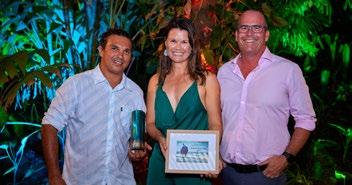



As closed borders, social distancing and travel bubbles became the new reality, TTNQ quickly pivoted to collect economic data demonstrating the region’s heavy reliance on tourism and the urgent need for a tailored wage subsidy to retain its workforce, along with broader business and tax relief.
“TTNQ moved faster than anyone else to build the case for support,” Olsen said. This advocacy paid off when the Federal Government announced a record $10 million in domestic marketing funding to help soften the $5.8 billion blow to the region’s tourism industry.
In October 2020, Skyrail Rainforest Cableway Chairman Ken Chapman, the son of inaugural Chairman George Chapman, took over as Chair to help steer TTNQ through
what became the most difficult three years in its history. “TTNQ demonstrated what well-resourced and well-managed destination marketing could achieve with domestic expenditure hitting a record $3 billion by March 2022, driving visitation to Queensland as the top performing region in the State,” Chapman said. Expenditure records continued for six quarters in a row until it reached $3.8 billion in December 2023.
With domestic markets recovering, lobbying shifted to international recovery. TTNQ’s domestic success was recognised in March 2022 when the Federal Government announced $15 million in funding for global campaigns, with activity rolling out during the 2023-2025 financial year.
While recovery was underway, Chapman also led a complete review of TTNQ’s constitution, establishing a skills-based board. The organisation officially adopted its new company name, Tourism Tropical North Queensland Limited on 11 January 2023.
Current Chair John O’Sullivan, CEO of Experience Co, was appointed in 2023. His first term was overshadowed by the severe flooding caused by ex-Cyclone Jasper, which devastated the region’s tourism infrastructure, severing major road links and closing the highway north of Palm Cove for five weeks. TTNQ again stepped up its advocacy to support a struggling industry.
From utter devastation comes extraordinary opportunity and TTNQ ended 2024-2025 by delivering 110 international trade campaigns driving a record $281 million in direct expenditure for the region with a 36:1 return on investment. It’s a proud achievement by the current team and one that reflects the outstanding achievements of the Tropical North Queensland tourism industry during the past 50 years. “Over five decades TTNQ
has looked for opportunity in every change to ride the bumps that are outside the organisation’s control and take charge of how we respond to it,” Olsen said.
